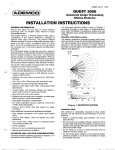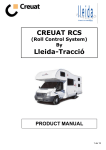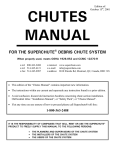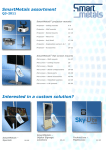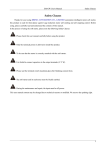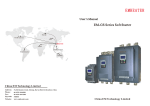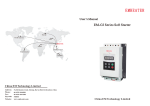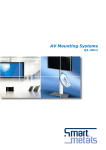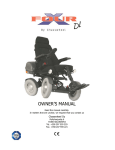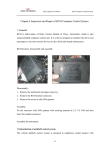Download 2200 Operators Manual.pub
Transcript
April 26, 2004 OPERATOR’S MANUAL 2200 SERIES LIFT - LIL’ HOISTER ! lift, NING WAR ting this this er a nd re op ndersta al. o f e u u B Man and he read erator’s ar with t nit. i u p l O fami s of this e m Beco l hazard NER . ntia ll SUM uestions pote Ca any q ve u ha if yo 20 Index Owner’s Responsibilities ..............................................................2 Operator Safety Instructions ........................................................3 Operating Procedure .............................................................. 5-10 Moving Lift to Work Area .......................................................5 Moving Lift with Load ............................................................5 Lifting and Lowering Loads ....................................................6 Reversing Forks.....................................................................6 Using Legs .............................................................................7 Carriage Safety Latch ............................................................8 Storing and Transporting Lift .................................................9 Options .......................................................................................11 Foot Brake ...........................................................................11 Work Tray ............................................................................11 Dually Wheel Kit ..................................................................11 Specifications .............................................................................12 Lift Diagram ................................................................................13 Load Capacity Chart ..................................................................14 Maintenance Instructions ..................................................... 15-16 Troubleshooting .........................................................................17 Maintenance Record ..................................................................18 MAINTENANCE RECORD ______________________________________________________________ Action Date ______________________________________________________________ Action Date ______________________________________________________________ Action Date ______________________________________________________________ Action Date ______________________________________________________________ Action Date ______________________________________________________________ Action Date ______________________________________________________________ Action OWNER’S RESPONSIBILITIES Throughout this publication, the words WARNING, CAUTION and IMPORTANT will be used to alert the user to special instructions concerning a particular operation that may be hazardous if performed incorrectly or carelessly. OBSERVE THEM CAREFULLY !! WARNING Hazards or unsafe practices which could result in severe personal injury or death. Date ______________________________________________________________ Action Date ______________________________________________________________ Action Date ______________________________________________________________ Action Date ______________________________________________________________ Action Date ______________________________________________________________ Action CAUTION Hazards or unsafe practices which could result in minor personal injury, product or property damage. Date ______________________________________________________________ Action Date ______________________________________________________________ Action IMPORTANT Date ______________________________________________________________ Indicates information or instructions that are necessary for proper operation and/or maintenance. 2 Action Date 19 OPERATOR SAFETY INSTRUCTIONS MAINTENANCE RECORD IMPORTANT Lift Model Number_____________________ Read and understand Operators Manual before using Lift. Lift Serial Number_____________________ Service Performed: ______________________________________________________________ Action Inspect strap before each use. Do not use if strap is frayed, worn, cut, burnt or otherwise damaged. Date ______________________________________________________________ Action Date ______________________________________________________________ Action Use only on solid level surface. Keep work are clean and clear of clutter and debris. Date ______________________________________________________________ Action Date ______________________________________________________________ Action Date Test load balance before lifting. Do not use without properly installing legs. Never exceed rated load capacity. ______________________________________________________________ Action Date ______________________________________________________________ Action Do not operate from an unstable platform, such as the bed of a truck. Date ______________________________________________________________ Action Date Stay clear of overhead wires and obstructions. ______________________________________________________________ Action Date ______________________________________________________________ Action Date Never operate in gusty winds. Lifting loads during high winds can result in the lift tipping over and the possibility of operator injury. ______________________________________________________________ Action Date ______________________________________________________________ Action Do not stand under an elevated load. Date ______________________________________________________________ Action Date Never leave lift unattended with an elevated load. 18 3 TROUBLESHOOTING Do not use to lift personnel. Do not sit or stand on forks. PROBLEM Masts not rising in succession Do not climb on mast or put a side load on mast. Do not use unit to support ladders for climbing or hoisting. Do not use unit outside in thunder, lightning, or severe weather. Wear proper clothing. Hard hat, safety shoes and gloves should be worn as a precaution when operating this lift. Avoid horseplay around equipment, and keep bystanders at a safe distance. Do not allow children to operate this unit and always keep them out of work areas. Do not misuse the lift. Perform only the functions for which the lift was designed. Never use two lifts in tandem to lift a load that exceeds the capacity of a single lift. Load is easing down slowly You have checked the winch and the brake does not work at all. The winch is hard to crank down. CAUSE SOLUTION Overloading Check to make sure that the load does not exceed the 300 lb/140 kilo load limit. Remove excess weight. Load may not be centered properly on the forks. Check load capacity and reposition load. Slideways obstructed. Inspect tracks for debris, grease, or any foreign obstruction. Clean mast sections with a degreaser or brake cleaner and lubricate with a silicon lubricant. Inspect Lifting Strap for damage. If Lifting Strap is cut, worn or frayed, replace the strap. Slideways are clean but masts still not sliding freely. Inspect mast sections for damage. Replace damaged mast section. The brake on the winch or ratchet dog are not installed correctly. When load is in position, crank winch handles forward a half turn towards the lift to set the brake. The brake ratchet or ratchet dog are not installed correctly or are damaged and/or worn. Replace the winch. The brake is over-engaged Remove the load and turn the winch handle counter clockwise. The brake will not disengage Replace the winch. Call distributor’s Customer Service Department. If none of these solutions seem to fix the problem... Prior to each use of the unit, inspect all moving parts and the lifting strap to ensure they are in proper working condition. NOTE: Mast sections may rise out of succession when load is near maximum capacity. If this occurs, the masts will correct themselves during continued use or when the load is removed from the forks. Movement of the mast sections will not affect the position of the forks. The carriage must elevate to the top of the top mast section before any mast sections begin to rise, and it should lower last. 4 17 10. Wind the slack cable tightly and evenly across the load drum. 11. Replace the winch covers. OPERATING PROCEDURE 1. Moving Lift to Work Area (No Load) General Maintenance: 1. Check the winch handle for wear or bends. 2. Inspect 3” roller wheels mounted on the winch for damage and smooth rotation. 3. Examine all bolts and nuts to be sure they are tight. 4. Legs, forks, braces and base should be dent free and damage free. 5. Check damage (indentations) which can restrict the rotation of the Lifting Strap. 6. Make sure Lifting Strap is seated flat and has no twists restricting rotation. 7. Check legs by sliding them into each position to check locking mechanism. 8. Inspect masts and carriage hold-down device. 9. Raise mast sections to inspect for free, smooth sliding action. Make sure slideways are free of dust and oxidation and spray a light coat of silicone lubrication in slideways. 10. Make sure caster wheels and 8” transport wheels rotate freely and are undamaged. 11. Check to be sure that all mast covers are attached to the lift. The lift is normally moved to the job site by tilting back and rolling on its 6” tires. Note: Do not pull by the load lifting strap. 2. Moving Lift in Work Area (With Load) Although it is best to move the unit to the job site unloaded, light loads may be transported as long as the unit is rolled on the casters and transport wheels on a level surface. Always have the load in the lowest possible position before moving the unit. CAUTION If a load is being transported, it should be secured to the forks to avoid shifting. WARNING Moving the unit with elevated loads should be contained to short distances; i.e., 10-15 feet/4-5 meters. WARNING Replace all worn or damaged parts only with Sumner parts. If it is necessary to move the unit with an elevated load: • • • • WARNING Modifying the lift in any way can cause injury or death! 16 Make sure the area is clear of obstructions Keep personnel away from the load and behind the operator’s position Move the unit slowly, avoiding sudden jerky starts and stops Make sure the load is secure and properly balanced. Note load capacity at given centers on page 14. 5 MAINTENANCE INSTRUCTIONS 3. Lifting and Lowering Loads Before each use: Use the winch to crank forks up or down into the desired position. Any unstable load must be balanced and secured to the forks prior to lifting. 1. Inspect the lifting strap for frays, cuts or burns. If any damage is visible on the lifting strap, do not use the lift. 2. Make certain winch operates freely and lifting strap is not tangled on the winch drum. 3. Check forks, legs, and base for bends. 4. Make sure caster wheels move freely. Recommended Inspection Every 6 Months: Turn winch crank clockwise to elevate the load, while watching for overhead obstructions. Turn winch handle counter clockwise to lower the load. Lower Raise CAUTION 1. Inspect the lifting strap for frays, cuts or burns. If any damage is visible on the lifting strap, do not use the lift. 2. Make certain winch works freely and that there are no loose or damaged parts. Winch Maintenance: 1. Be sure that both winch covers are on the winch. 2. Check ratchet dog and brake ratchet for wear. If any wear is visible, replace the winch. If not, lubricate both parts with a light oil. 3. Inspect gear teeth for wear. If there is no sign of visible wear, brush teeth with 50-wt. Motor oil. 4. For proper brake adjustment see “Troubleshooting” section on page 17. Make sure the floor surface is level. WARNING No riders allowed on this unit. This is not a personnel lift and never should be used for hoisting or moving people. Replacing the Lifting Strap: 1. Lower the carriage to engage the safety latch. 2. Remove the large gear cover from the winch. 3. Unbolt the bracket from the top of the front mast. 4. Removing and Reversing Forks 4. Slide the Lifting Strap Attachment Pin out of the bracket and out of the eye on the strap. The forks on the 2200 series lift are removable. Removing the forks is recommended for storage and is required for reversing. The forks may be reversed to allow for an increased lifting height. 5. Use the winch to pull the old Lifting Strap through the lift. Make note of the direction of the reeve. 6. Remove the bolt attaching the Lifting Strap to the drum and remove the old Lifting Strap. 7. Pin the new Lifting Strap (non-labeled end) to the top mast bracket. 8. Re-reeve the new Lifting Strap through the lift using notes taking in step 5. To aid in the installation and retention of the forks, a small “hook” has been placed inside the fork weldment. 9. Attach new Lifting Strap to winch drum using bolt from step 6. Note: The Lifting Strap must be fed from the bottom of the winch over the right side of the drum (looking from the back of the lift). Winding the Lifting Strap over the left side of the drum will prevent the brake from working. 6 15 LOAD CAPACITY CHART WARNING The center of gravity of the load should never extend past 20” from the carriage. WARNING The center of gravity of the load should always be centered between the fork arms and as far back towards the lift as possible. To remove the forks, disengage the two spring loaded pins. Rotate the top section of the fork away from the lift while simultaneously sliding the fork down. Sliding the fork down will release the hook engagement from the back of the carriage. Reverse this procedure to install the forks. To invert the forks, rotate the forks 180°. Place the heel of the fork down onto the carriage. This will engage the hook onto the back of the carriage. Pull rings on the spring loaded plungers simultaneously while rotating the fork assembly back towards the lift. 2200 Series Lift Capacity 5. Using the Legs 350 The 2200 Series Lift will arrive with the legs in the upright storage position. Before attempting to attach the forks and use the lift, the legs must be rotated to the operating position. Load (lbs) 300 250 200 150 100 13 16 19 Distance from Face of Forks (in) 14 22 CAUTION Attempting to install the forks and/or use the lift with the legs in the storage position will result in the lift being unstable. 7 LIFT DIAGRAM To reposition the legs, lay the lift down on a flat level surface. Using one hand, pull the spring loaded pin while sliding the leg out of the base with the other hand. Rotate the leg 90° and reinsert it into the base with one hand while pulling the spring loaded plunger with the other hand. Repeat this procedure for the other leg. Top Mast Bottom Mast Mast Brace The legs can be positioned in two configurations, narrow and wide. The narrow configuration allows access into confined spaces. While not required, the wide configuration allows for greater stability on lifts greater than 8 ft. Carriage Assembly WARNING Lifting a load without the spring loaded pins fully engaged in the leg locating holes can cause the lift to become unstable and/or tip over. 6. Carriage Safety Latch Lifting Forks Winch Assembly Carriage Safety Latch The 2200 Series Lift will arrive with the Carriage Safety Latch engaged to the carriage. The purpose of the latch is to prevent the mast sections from extending during transportation. To use your lift, disengage the Safety Latch from the carriage and install the legs and forks into their operating positions. 8 Base Leg Optional Foot Brake 8” Transport Wheels 13 45.0 53.3 26.9 48 kg 17.7 21 10.6 106 lb 300 lb 43 kg 140 kg Reverse this procedure to remove the Safety Latch. 45.0 53.3 26.9 300 lb 140 kg 300 lb 140 kg 95 lb 41 kg 89 lb 38 kg (in.) 57.7 12.5 57.7 40.3 25.3 31.3 0.8 1.5 49.7 62 17.7 21 10.6 83 lb 300 lb Fork Specifications Fork Width Fork Length Fork Weight Weight Net Weight Load Capacity (13" L.C.) 2204 2206 45.0 53.3 26.9 17.7 21 10.6 45.0 53.3 26.9 17.7 21 10.6 2208 (in.) 57.7 12.5 57.7 40.3 25.3 31.3 0.8 1.5 95.9 108.2 7. Storing and Transporting the Lift (cm) 109.2 31.8 109.2 102.4 64.3 79.5 2.0 3.8 167.4 198.6 (in.) 43 12.5 43 40.3 25.3 31.3 0.8 1.5 65.9 78.2 (cm) 146.6 31.8 146.6 102.4 64.3 79.5 2.0 3.8 126.2 157.5 When operating the lift, the Safety Latch can be looped onto itself for out-of-the-way storage. In the event that you accidentally crank on the winch before disengaging the Safety Snap, the rubber stopper will be pulled through the housing, preventing damage to the lift. To reset the Safety Latch, replace the rubber stopper into the housing using the side access slot. Dimensions Height Stowed Length Stowed Height Operating Length Operating Base Width (Narrow) Base Width (Wide) Ground Clearance Load Height (minimum) Maximum Height (forks down) Maximum Height (forks up) SPECIFICATIONS (cm) 146.6 31.8 146.6 102.4 64.3 79.5 2.0 3.8 243.6 274.8 2210 140 kg (cm) 177.0 31.8 177.0 102.4 64.3 79.5 2.0 3.8 304.5 335.8 (in.) 69.7 12.5 69.7 40.3 25.3 31.3 0.8 1.5 119.9 132.2 The Carriage Safety Latch may be engaged to either the carriage or the forks. When engaging onto the forks, lower the carriage all the way down. Clip the Safety Snap onto the Safety Latch Loop on the side of the Fork Assembly. 12 To store and/or transport the lift, remove the forks (described in section 4), place the legs in the storage position (described in section 5 and reverse the winch handle. To reverse the winch handle, pull the spring loaded pin with one hand while sliding the handle off with the other hand. Rotate the handle 180° and reinstall. This places the winch handle in a secure location for transportation or storage. 9 OPTIONS Foot Brake (784218) With the legs and winch handle in the storage positions, the lift is compact and can be stowed easily in the upright position. When transporting the lift, it may be necessary to use the 3” winch transport wheels to aid in loading the lift in a truck or van. To do this, pull the spring loaded pin with one hand, while rotating the wheel assembly with the other. When the wheel assembly is fully rotated, the spring loaded pin will lock it in place. Note: With the 3” wheels rotated out and locked into the transport position, the winch handle can not be rotated. To load the lift into a truck or van, lean the lift back onto the winch side until the 3” wheels contact the truck bed. Raise the bottom end of the lift, and roll the unit into position. The 2200 Series Lift can be outfitted with an optional foot brake. The brake can be installed at the factory, or can be ordered as an add on item at any time. When engaged, the brake will prevent the 8” transport wheels from rotating. To operate the brake, press the brake pad with your foot until the brake locks into place. When you hear the “snap” you know the brake is locked into place. To release the brake, slide your foot underneath the brake pad and raise up until the brake unlocks. When you hear the “snap” you will know the brake is unlocked. Work Tray (784240) The 2200 Series Lift can be outfitted with an optional work tray. The tray slides easily on and off without removing the existing forks. CAUTION Safety Brakes are recommended when using the optional work tray. Dually Wheel Kit (784258) CAUTION Make sure the Mast Safety Latch is securely attached to the carriage/forks before transporting the lift. 10 The 2200 Series Lift can be outfitted with an optional dually wheel kit. The dually wheels provide extra support when the lift is used as a hand truck or when it is used on irregular terrain. 11










